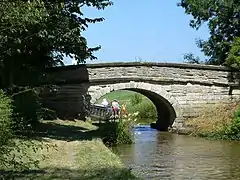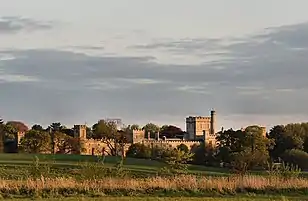Listed buildings in Moreton cum Alcumlow
Moreton cum Alcumlow is a civil parish in Cheshire East, England, United Kingdom. It contains 13 buildings that are recorded in the National Heritage List for England as designated listed buildings. Of these, one is listed at Grade II*, the middle grade, and the others are at Grade II. The major building in the parish is Great Moreton Hall; this and a number of structures associated with it are listed. The Macclesfield Canal runs through the parish, and four bridges crossing it are listed. Apart from the estate of Great Moreton Hall, the parish is rural, and two farmhouses are also listed.
Key
| Grade | Criteria[1] |
|---|---|
| II* | Particularly important buildings of more than special interest |
| II | Buildings of national importance and special interest |
Buildings
| Name and location | Photograph | Date | Notes | Grade |
|---|---|---|---|---|
| Lodge Farmhouse 53.12473°N 2.21274°W |
— |
1653 | The farmhouse is built in rendered sandstone. It is in two storeys with an attic, and has an entrance front of two bays. On the right are a 20th-century porch and a 19th-century wing. The windows are mullioned, and contain casements. Inside the farmhouse is a blocked inglenook.[2] | II |
| Boathouse 53.13516°N 2.24392°W |
— |
18th century | This originated as a brick farm building, and was converted into a boathouse when the lake was created in the 19th century. It is in two storeys with an attic. The lake front has a stone lower floor containing an archway. The upper part is timber-framed and jettied with decorative bargeboards. Behind is part of the original brick building with a slate roof. Other features include a brick tower and a canted bay window.[3][4] | II |
| Bridge No. 82 53.13453°N 2.22541°W |
— |
c. 1827 | An accommodation bridge crossing the Macclesfield Canal, for which the engineer was William Crosley. It is built in sandstone and consists of a single horseshoe arch with voussoirs, keystones, and parapets. There are curved retaining walls ending in square piers.[5] | II |
| Bridge No. 83 53.13213°N 2.22725°W |
 |
c. 1827 | The bridge carries Wharf Lane across the Macclesfield Canal, for which the engineer was William Crosley. It is built in sandstone and consists of a single horseshoe arch with voussoirs, keystones, and parapets. There are curved retaining walls ending in square piers.[6] | II |
| Bridge No. 84 53.13049°N 2.22856°W |
 |
c. 1827 | An accommodation bridge crossing the Macclesfield Canal, for which the engineer was William Crosley. It is built in sandstone and consists of a single horseshoe arch with voussoirs, keystones, and parapets. There are curved retaining walls ending in square piers.[7] | II |
| Bridge No. 85 53.12789°N 2.23074°W |
— |
c. 1827 | The bridge carries New Road across the Macclesfield Canal, for which the engineer was William Crosley. It is built in sandstone and consists of a single horseshoe arch with voussoirs, keystones, and parapets. There are curved retaining walls ending in square piers.[8] | II |
| Great Moreton Hall 53.13244°N 2.24119°W |
 |
1841–43 | A castellated country house in Gothic style designed by Edward Blore. It is built in sandstone with slate roofs. The main part of the house is in two storeys, flanked by towers of three and four storeys, and has a front of six bays. To the left is a service range. At the front of the house is a porte-cochère.[9][10][11] | II* |
| Icehouse tower, Great Moreton Hall 53.13239°N 2.23990°W |
— |
1841–43 | The icehouse tower was designed by Edward Blore and is built in sandstone. It is hexagonal and in three storeys. In the lowest stage is a two-light window, with lancets in the upper stages. Inside is a brick tunnel vaulted corridor leading to a circular domed chamber.[3][12] | II |
| Summerhouse and wall, Great Moreton Hall 53.13148°N 2.24207°W |
— |
1841–43 | The summerhouse was designed by Edward Blore. It is built in sandstone, is octagonal in shape, is in two storeys, and has a castellated parapet. The summerhouse is linked to a stone wall carrying a raised walkway. There are two doors in the upper storey linking to the walkway, and a door in the lower storey leading into the garden. The upper storey also contains lancet windows.[3][13] | II |
| West Lodge, Great Moreton Hall 53.13659°N 2.25346°W |
 |
c. 1841–43 | The gate lodge, designed by Edward Blore, is built in sandstone with a roof of cement tiles. It is in a single storey, and has a T-shaped plan. The entrance front has a gabled bay containing a bay window, above which is a brattished parapet. In the gable is a niche containing a heraldic shield. The gate piers at the entrance to the drive are included in the listing.[3][14] | II |
| Garden wall and outbuildings, Great Moreton Hall 53.13306°N 2.23861°W |
— |
Mid 19th century | The garden wall is in brick, surrounds the former kitchen garden, and is attached to outbuildings. At the northwest corner is Fern House, a restored former greenhouse. Against the north face of the north wall is another outbuilding, in brick with a tiled roof, now stretching for 13 bays. Two of these bays form the Mushroom House, which contains 36 arched recesses for mushroom beds.[3][15] | II |
| East Lodge, Great Moreton Hall 53.13366°N 2.23300°W |
 |
1858 | The gate lodge is built in sandstone with a tiled roof. It is in two storeys with wings of a single storey, and contains Tudor details. On the drive front is a semi-octagonal bay window containing casements. At the top of each face is a steep gable with decorative bargeboards. The central gable contains a shield with a coat of arms and the date.[3][16] | II |
| Home Farmhouse 53.13516°N 2.23355°W |
— |
1871 | The farmhouse is built in concrete with ashlar dressings and a tiled roof in two storeys. The entrance front has a projecting right gabled bay containing a two-storey bay window. In the house are cross-windows and casements with lattice glazing.[17] | II |
References
Citations
- Historic England
- Historic England & 1330037
- Hartwell et al. (2011), p. 380
- Historic England & 1330071
- Historic England & 1138731
- Historic England & 1138732
- Historic England & 1138733
- Historic England & 1138734
- Hartwell et al. (2011), pp. 379–380
- de Figueiredo & Treuherz (1988), pp. 103–106
- Historic England & 1138736
- Historic England & 1138737
- Historic England & 1330036
- Historic England & 1161798
- Historic England & 1138722
- Historic England & 1330035
- Historic England & 1138735
Sources
- de Figueiredo, Peter; Treuherz, Julian (1988), Cheshire Country Houses, Phillimore, ISBN 0-85033-655-4
- Historic England, "Lodge Farmhouse, Moreton cum Alcumlow (1330037)", National Heritage List for England, retrieved 16 May 2014
- Historic England, "Boathouse at Keepers Farm, Moreton cum Alcumlow (1330071)", National Heritage List for England, retrieved 16 May 2014
- Historic England, "Bridge No 82, Moreton cum Alcumlow (1138731)", National Heritage List for England, retrieved 16 May 2014
- Historic England, "Canal Bridge No 83, Moreton cum Alcumlow (1138732)", National Heritage List for England, retrieved 16 May 2014
- Historic England, "Canal Bridge No 84, Moreton cum Alcumlow (1138733)", National Heritage List for England, retrieved 16 May 2014
- Historic England, "Canal Bridge No 85, Moreton cum Alcumlow (1138734)", National Heritage List for England, retrieved 16 May 2014
- Historic England, "Great Moreton Hall, Moreton cum Alcumlow (1138736)", National Heritage List for England, retrieved 16 May 2014
- Historic England, "Icehouse tower at Great Moreton Hall, Moreton cum Alcumlow (1138737)", National Heritage List for England, retrieved 16 May 2014
- Historic England, "Summerhouse c. 45 metres west of Great Moreton Hall and attached wall, Moreton cum Alcumlow (1330036)", National Heritage List for England, retrieved 16 May 2014
- Historic England, "West lodge and attached gatepiers to south, Moreton cum Alcumlow (1161798)", National Heritage List for England, retrieved 16 May 2014
- Historic England, "Garden wall, attached outbuilding incorporating Mushroom House and corner outbuilding at Great Moreton Hall, Moreton cum Alcumlow (1138722)", National Heritage List for England, retrieved 16 May 2014
- Historic England, "East Lodge, Moreton cum Alcumlow (1330035)", National Heritage List for England, retrieved 16 May 2014
- Historic England, "Home Farmhouse, Moreton cum Alcumlow (1138735)", National Heritage List for England, retrieved 16 May 2014
- Historic England, Listed Buildings, retrieved 1 April 2015
- Hartwell, Clare; Hyde, Matthew; Hubbard, Edward; Pevsner, Nikolaus (2011) [1971], Cheshire, The Buildings of England, Yale University Press, ISBN 978-0-300-17043-6
This article is issued from Wikipedia. The text is licensed under Creative Commons - Attribution - Sharealike. Additional terms may apply for the media files.